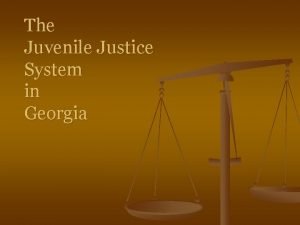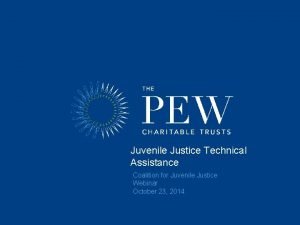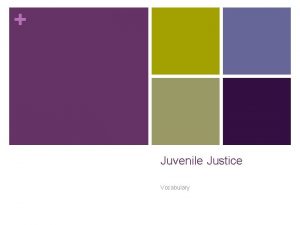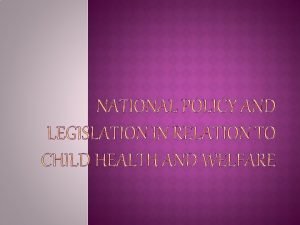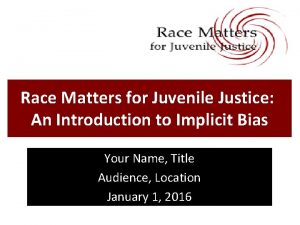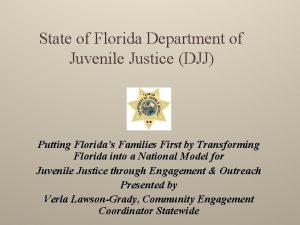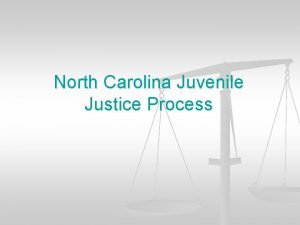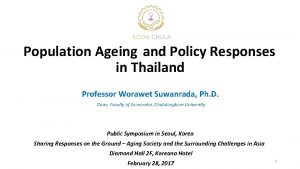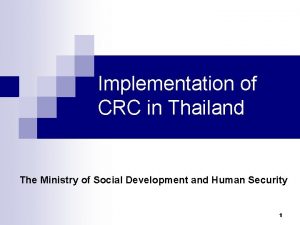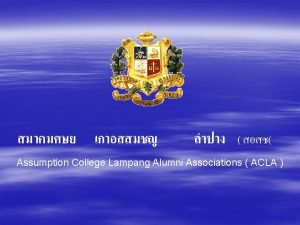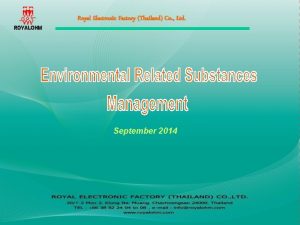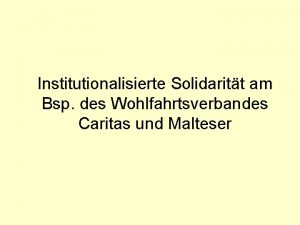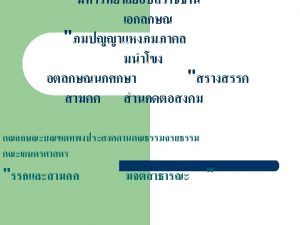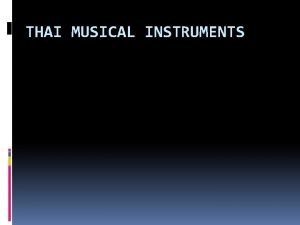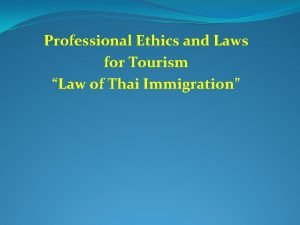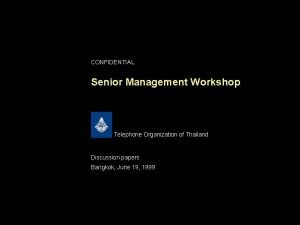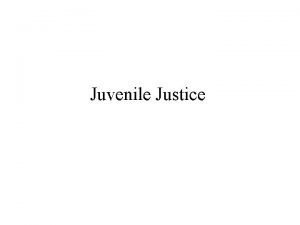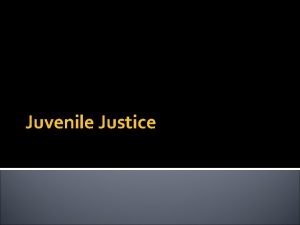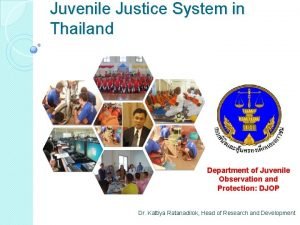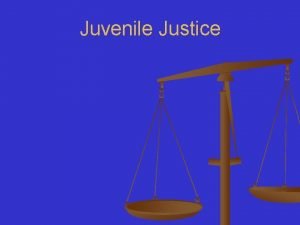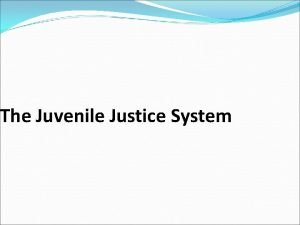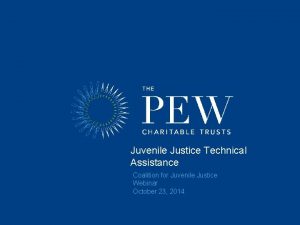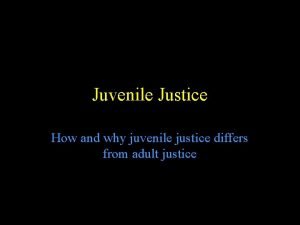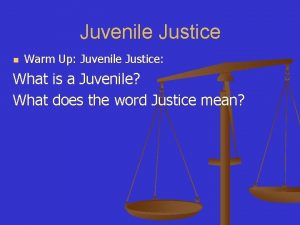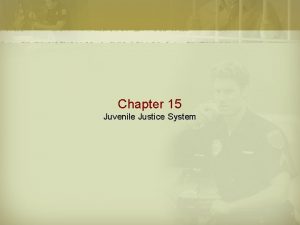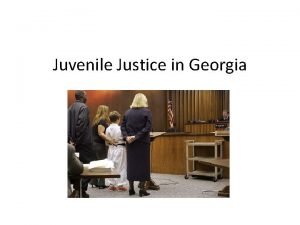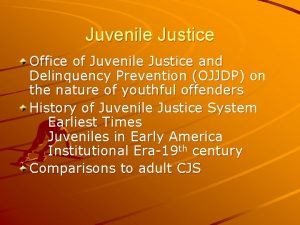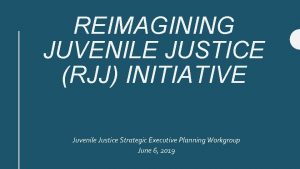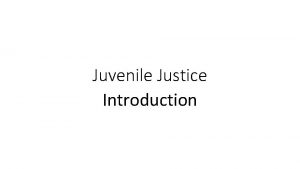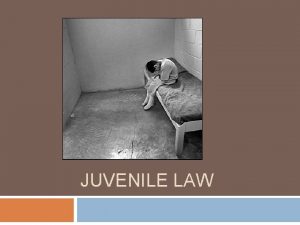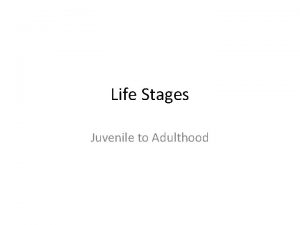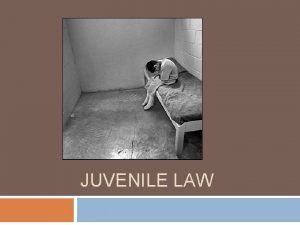Juvenile Justice in Thailand Are we on the














































- Slides: 46

Juvenile Justice in Thailand Are we on the right track?

Thai Juvenile Courts: History • Separate court since 1951 • the Act Instituting Juvenile Courts and the Juvenile Procedure Act (1951) creating “Juvenile Court and Child Observation and Protection Centre” • the first time ever that juvenile treatment and rehabilitation were appropriately established and implemented

Thai Juvenile Courts: History • Act for Establishment of and Procedure for Juvenile and Family Court (1991) to protect family’s rights and child’s rights too. • To adjudicate cases by following the international idea is that families are an important foundation of community: family problems affect each family member life and mentality. • The Juvenile Court and Child Observation and Protection Centre were renamed “the Juvenile and Family Court” and “the Juvenile Observation and Protection Centre”

Thai Juvenile Courts: History • At that time, aiming to create nationwide JFCs • Later in 2002, the Juvenile and Family Court was under the Office of the Judiciary, while the Juvenile Observation and Protection Centre was under MOJ • By 2003, we have JFCs in every 77 provinces, 2 JFCs in Bangkok • Current law is Juvenile and Family Court and Procedure Act (2010)

Age of criminal responsibility - The lowest age at which a person can be convicted of a criminal charge is 10 years old - “A child below 10 years of age, who commits a criminal offence, is not liable to punishment” - The child will be sent to child protection - Other countries?

Age of criminal responsibility • From the age of 10 to 15, this child cannot be punished, the court can proceed with certain measures for example: • admonish the child before releasing him or her. If appropriate, the court may also admonish the child's parents, legal guardian or those with whom he or she is living; • If the court considers that the child's parents can take care of him or her, the court may order the child to be consigned to the care of the parents, on condition that the parents ensure that the child does not commit another offence for a certain court-decreed period of time, which must not be more than three years. •

Age of criminal responsibility • child older than 15 but younger than 18: the court may consider the child's sense of responsibility and other attributes before deciding whether he or she deserves punishment. If the court decides against punishment, it may proceed according to the measures described above. If the court decides to punish the child, it should reduce the punishment by one half.

Age of criminal responsibility • All this was amended in 2008 to be in line with Convention on the Rights of the Child and ICCPR. • Art. 40 (3) of CRC requires States parties to seek to promote, inter alia, the establishment of a minimum age below which children shall be presumed not to have the capacity to infringe the penal law, but does not mention a specific minimum age in this regard: an obligation for States parties to set a minimum age of criminal responsibility.

Age of Criminal Responsibility • In the original general comment No. 10 (2007), the Committee had considered 12 years as the absolute minimum age. However, the Committee finds that this age indication is still low. States parties are encouraged to increase their minimum age to at least 14 years of age. At the same time, the Committee commends States parties that have a higher minimum age, for instance 15 or 16 years of age.

Fair Trial • The right to effective participation in the proceedings during both investigation and trial ▫ done in an appropriate place with no discrimination and does not mix with other accused or has no unrelated person ▫ conducted in an easily understandable language or wording ▫ the legal advisor must be presented ▫ a father, a mother, a guardian or any person or organization with in which the child or juvenile resides may attend the inquiry ▫ Trial done in a special court room that is not used for conducting ordinary case, JFC judges don’t wear gowns

Fair Trial • The right to effective participation in the proceedings during both investigation and trial ▫ full opportunity to the delinquent as well as his or her father, mother, guardian or the person with whom the delinquent is residing with to state facts, feeling and opinions and to produce witnesses as well as to cross examine witnesses at any stage of the trial.

Fair Trial • Prompt notification of charges and decisions without delay ▫ Time limits for every step, judgments within 6 months from the time of filing • Full respect of privacy • No person shall take a picture, broadcast, print out picture, voice record, or make available the voice of the juvenile alleged to have committed an offence or related person or publicize any statement in the investigation of or in the trial that may cause other persons to be able to identify the juvenile or family name of such juvenile or advertise the statement disclosing the criminal record, or domicile, office, or academic institution of such juvenile > criminal punishment

Fair Trial • Automatic removal from the criminal records of children who committed an offence upon reaching the age of 18, and in the case of serious offences to allow removal at the request of the child, if necessary under certain conditions> no provision yet

Measures/Interventions • “States should continuously explore the possibilities of avoiding a court process or conviction, through diversion and other measures. ” • Should start before a trial commences and should continue throughout the proceedings

Measures/Interventions • 1. Measures without resorting to judicial proceedings (diversion) See Article 40 (3) of the CRC; • 2. Measures in the context of judicial proceedings (disposition) • including serious offences?

1. Diversions: Safeguards • • Juveniles freely and voluntarily admit responsibility Juveniles give consent to the diversion Must still be able to have legal assistance Police, prosecutors and/or other agencies to make decisions re diversions should be regulated and reviewed • Measures must be able to be reviewed by authority • Completion of the diversion should result in a definite and final closure of the case

1. Diversions: Conditions • Type of offenses; should also include serious offenses? • Juvenile may reform himself/herself taking into account many factors • Victim compensation/restitution • First offender? • Victims consent? • Repenting, showing remorse? • Should we require the delinquent to admit guilt as a condition for participation, should we consider if an admission is not needed to promote the goals of the program?

1. Diversions: Conditions • Many diversion programs require and depend upon the offender admitting guilt to at least some of the charges they are facing. The specific requirements for guilty pleas vary, with some drug courts requiring guilty pleas to all or the majority of charges. Some, or all, charges that may otherwise have been contested then form part of the individual’s official offence history. The requirement to plead guilty in order to qualify for diversion can lead to a fundamental aberration of justice whereby the offender who does not plead guilty faces not only a possibly more onerous path but a perception by a range of criminal justice decision-makers that they are ‘recalcitrant’ or ‘uncooperative’. • Lynne Roberts & David Indermaur, Timely Intervention or Trapping Minnows? The Potential for a Range of Net-Widening Effects in Australian Drug Diversion Initiatives, Psychiatry, Psychology and Law, 13: 2 (2006), 220 -231 at 226

1. Diversions: Types of Measures • Wide range of appropriate programs: community service, supervision and guidance by social workers or probation officers, family conferencing and other forms of restorative justice including compensation to victims.

1. Diversions in Thailand • “Pre-filing diversion” ▫ If a juvenile may reform himself or herself without prosecution ▫ the Director of the Observation Center may order that a rehabilitation plan for the juvenile. The Director of the Observation Center may require his or her father, mother, guardian, or any persons or entities with which the juvenile resides to comply with such plan

1. Diversions in Thailand ▫ During preparation and implementation of the rehabilitation plan, an inquiry officer or a public prosecutor shall suspend the questioning or any proceeding in relation to the juvenile ▫ When the implementation of the plan is completed, the public prosecutor shall have a power to make a non prosecution order ▫ An injured person is still entitled to file a civil complaint.

1. Diversions in Thailand • “post-filing diversion” ▫ the court may order the Director of the Observation Center or any person who the court deems appropriate to prepare a rehabilitation plan ▫ If the court approves the plan, the court shall order the juvenile and any person concerned to implement such plan and the court shall temporarily dispose of the case ▫ If the Rehabilitation plan is fully complied with, the court shall dispose the case ▫ The rights to institute a criminal prosecution are extinguished but an injured person is still able to file a civil complaint

2. Dispositions • Deprivation of Liberty as a last resort • Any alternatives to incarceration? Possible diversion at this stage? • Some countries have diversion after conviction

2. Dispositions: Supervised Release • In case where the court deems inappropriate to make a judgment, or there is a request, the court may, after inquiring an injured person, suspend a judgment and place certain measures • Such conditions shall remain within a period of time but not exceeding the time by which the juvenile attains the age of 24 • When conditions are fulfilled, the court shall dispose of the case without rendering a judgment

2. Dispositions: Conditions of supervised release

2. Dispositions: non-custodial measures • Suspended sentence: more relaxed rules than adults • Handing the child back to parents or verbal sanctions

Juvenile Detention • Taking into account of personal circumstances, even in serious offenses • Best interests as a primary consideration • Promoting reintegration • Maximum punishment for children?

Family and Community Group Conferencing (FCGC) • New Zealand’s Family Group Conferencing (FGC) during a training session on child-friendly procedures for abused children, organized by the New Zealand Government as part of the Good Governance Program in 2000 • Other models for restorative justice such as Canada’s First Circle methodology and the Real Justice approach of the International Institute for Restorative Practices • Incorporating the component of ‘community’ as a model similar to the traditional justice practice in Thailand.

Family and Community Group Conferencing (FCGC) • FCGC provides an avenue for children and their parents to jointly and openly discuss problems and participate in the decision making that will affect their lives. It also gave the community an opportunity to provide support to children and families to cope with the problems that also affect the community. This led to the restoration of social harmony. • The Thai model has become the FCGC which was implemented in early 2003 with technical support from UNICEF.

Family and Community Group Conferencing (FCGC) • Pre-filing diversion (Section 86 of Juvenile and Family Court Act) • post-filing diversion (Section 90)

FCGC in Section 86 • Main Coordinator is Director of Observance Center • Parole officer will do evaluation, interview both juveniles and victims and send the case over to the Director • The Director will order family conferencing; participants may include the delinquent, family, victims, inquiry officers, social workers, psychologists, parole officers, community leaders, and public prosecutors

FCGC in Section 86 • Output is a rehabilitation plan for the public prosecutor to approve; the duration is normally 1 year • A conference facilitator and a plan administrator can be either a social worker, a psychologist or a parole officer; must go through mandatory training • Can/should we do family conferencing in a case where no individual is an injured person? Narcotic case? Racing on public roads (street racing)? • What terms should be in a rehabilitation plan? • Most of the cases we do are assault and theft

Problems? • Victims and their families do not understand the process and its objectives, have faith in the main justice system, want the judgments more • In urban area such as Bangkok, no cooperation, participation from the community, even the families of the delinquent • Lack of effective evaluation • No money for bail during the program ▫ Result = not popular

FCGC in Section 90 • More serious offenses like, sexual assault, battery, child abduction for sexual purpose (an offence punishable for a maximum term of imprisonment not exceeding twenty years) • Needs consent from victims • The court will order the rehabilitation plan to be made; usually court staffs (psychologists of the court) will prepare

FCGC in Section 90 • Main coordinator is the Juvenile and Family Court • The psychologists will coordinate with a lay judge who will be a conference facilitator • Participants may include the delinquent, his/her family, victims, lay judges, psychologists of the court, and community leaders • Plan administrators are lay judges and a psychologist of a court • More popular than Section 86

Problems • Since it deals with more serious crime, victims feel ashamed, not wanting community to be involved • More about money talk • Not many meaningful activities and projects for the delinquent to attend • Lack of personnel, the court wants to have its own social workers to develop a plan and to follow up (lay judges have terms, psychologists of a court are overwhelmed) • Lack of continuity of work, as juvenile and family judges tend to rotate often • This diversion process too lengthy

Case Study 1 • Mr. A 16 yrs old, in school, stay with family, tried alcohol and cigarettes, never tried drugs (Auto Theft) • Cause of committing a crime • Family did not pay much attention, parents agreed to buy him a motorcycle but never lived up to the promises. One day found a motorcycle parked with key in, so he took the motorcycle back to his own home to allow the owner to take it back and to show his parents that he still wanted a motorcycle. The owner went to his place and found the motorcycle in the same condition, no damage, no alteration. The owner did not want to press charge, and agreed to the diversion process. (Auto theft is noncompoundable offense)

Case Study 2 • Mr. M, age 16, the victim is 14, graduated 6 th grade, working day to day, parents are separated, living with his mother but his mother always went out of town, He works a lot, has savings (Child Abduction) • Cause of committing a crime: he and the victim were dating. On that day, the victim refused to go home and she stayed the night at M's house • The victim also refused to go to school since she was seeing M. Her family was really worried and would like her to go back to school. Her granddad was devastated and so sad that he got ill. • M apologized to her family and agreed to take care of her. He also paid 900$ out of his own savings to the family.

Case Study 3 • Mr. O age 16, studying his 9 th grade, an orphan living with a monk in a temple in Chiangmai. In the neighborhood, teens like to gather and play video games. The temple tries to have the orphans under their care to do farming during their free time. • Mr. O has HIV from birth and has below average IQ. He had behavioral problems, cannot control his sexual urges but in general he appears as a polite kid (Child Abduction)

Case Study 3 • Cause of committing a crime • Mr. O and the victim were at the same school and they were in a relationship. They had one protected sex, Mr. O tried to have another 2 unprotected sex with the victim but she refused. • From the first blood test, the victim did not have HIV. The victim's father said that the school administration dismissed the problem. The victim was not offered any help or compensation, was blamed by the community. The monk overprotected Mr. O. • Mr. O said he loved the victim but could not show much repentance due to his mental problem. He could not tell how his action could cause bad consequence to the victim. • The monk had to pay compensation to the victim's family and both the monk and the head teacher agreed to separate both as requested by the victim's family. • Mr. O felt guilty that the temple had to pay compensation on his behalf

Case Study 4 • In 2010, Miss P was 16 when she recklessly drove her car on express way into a Thammasat University van on Dec. 27, 2010, killing nine people, including 4 university students and 4 academics on 10 Jan 2011. She had no driver license. • She borrowed a car from her older friend • Juvenile and Family court found P guilty of reckless driving leading to deaths of others, and handed her a three year suspended prison sentence and mandatory community service of 48 hours within 2 years by taking care of patients injured from reckless driving.

Case Study 4 • She was ordered to be under supervision of parole officer for 2 years • She was also barred from driving until she is 25. • A Court of Appeal later upheld the ruling and increased her suspended sentence to four years and her community service to 48 hours per year for 3 years. • the Supreme Court rejected her appeal

Clearance Rate Report from Jan-July 2019 Incoming criminal cases Finished Pending Percentage of finished cases 10, 800 8, 712 1, 368 86. 43

Report of pre-filing diversion from Jan. July 2019 • 782 complete cases • 4 unlawful plans • Top 5 criminal offenses of pre-filing diversion ▫ ▫ ▫ Narcotic offenses 335 cases Traffic offenses 333 cases Gambling 26 cases Assault/battery 20 cases Theft 10 cases

Report of post-filing diversion from Jan-July 2019 Court Previous cases Incoming cases Complete cases Nonsuccessful cases Pending cases JFCs nationwide 496 411 301 49 622 Top 5 criminal offenses of post-filing diversion Assault/battery 45 cases Sexual assault of girl aged below 15 years 36 cases Theft 35 cases Narcotic offenses 34 cases Public roads offenses 28 cases

Report of Supervised Release Disposition Court Previous cases Incoming cases Complete cases Nonsuccessful cases Pending cases JFCs nationwide 8, 753 6, 558 5, 987 380 9, 320 Top 5 criminal offenses of supervised release Narcotic offenses 3, 331 cases Theft 695 cases Possession of firearms 376 cases Traffic offenses 332 cases Assault/battery 218 cases
 Antigentest åre
Antigentest åre Georgia juvenile justice system
Georgia juvenile justice system Coalition for juvenile justice
Coalition for juvenile justice Juvenile justice vocabulary
Juvenile justice vocabulary Juvenile justice act 2000
Juvenile justice act 2000 Race matters for juvenile justice
Race matters for juvenile justice Minnesota juvenile justice system
Minnesota juvenile justice system State of florida department of juvenile justice
State of florida department of juvenile justice North carolina juvenile justice process
North carolina juvenile justice process Criminal law and juvenile justice unit 2
Criminal law and juvenile justice unit 2 Expulsion
Expulsion Juvenile justice system in georgia
Juvenile justice system in georgia R.a. no. 9344
R.a. no. 9344 Vem tooling
Vem tooling Aging in thailand
Aging in thailand Proper adjective
Proper adjective Jupiter logistics (thailand) co. ltd
Jupiter logistics (thailand) co. ltd Crc thailand
Crc thailand Ren thai
Ren thai Fls 1993 (thailand) co. ltd
Fls 1993 (thailand) co. ltd Assumption college lampang
Assumption college lampang Aimsa thailand
Aimsa thailand Fulbright scholarship thailand
Fulbright scholarship thailand Renewable energy law thailand
Renewable energy law thailand Delta electronics (thailand) pcl
Delta electronics (thailand) pcl Amazing race thailand
Amazing race thailand Tourism legislation and professinal ethics
Tourism legislation and professinal ethics Royal electronic factory (thailand) co. ltd
Royal electronic factory (thailand) co. ltd Hope rehab thailand
Hope rehab thailand What thailand was previously known as
What thailand was previously known as Pray for thailand
Pray for thailand Hope rehab thailand
Hope rehab thailand Fba anwalt thailand
Fba anwalt thailand Dilaka
Dilaka Office of agricultural economics thailand
Office of agricultural economics thailand Nlp training thailand
Nlp training thailand Thailand
Thailand Vietnam thailand
Vietnam thailand Thailand gdp by sector
Thailand gdp by sector Musical instruments of thailand
Musical instruments of thailand Delmar international (thailand)
Delmar international (thailand) Materi ips kelas 6 sd tentang asean
Materi ips kelas 6 sd tentang asean Thailand former name
Thailand former name Mc chain food
Mc chain food Walter wintersteller
Walter wintersteller Halal logo thailand
Halal logo thailand Rotary youth exchange thailand
Rotary youth exchange thailand

